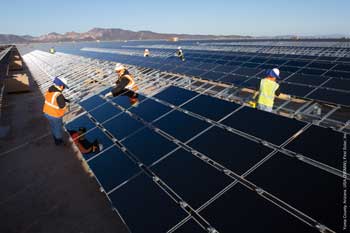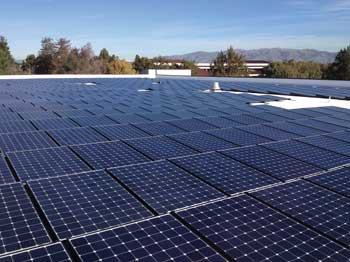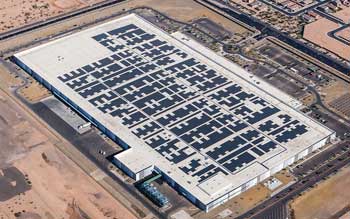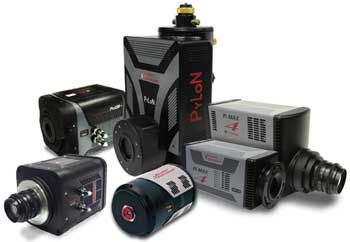Optoelectronics firms worldwide are going green by recycling, reducing energy use and even installing solar panels to be good to the planet and their communities while helping their bottom lines. It’s only natural.
Sustainability is a growing theme in global business, politics and culture, thanks to evidence for climate change and the pressure exerted on the Earth’s limited resources by a growing population. The motivations of photonics companies to participate in sustainability efforts are similar to those of businesses in general. Some, such as photovoltaics (PV) firms, have had “green” mandates from day one: It’s written into company DNA. Recycling and conservation efforts come naturally to a company that designs solar panels. Other businesses have little or nothing to say about sustainability, or they participate only if regulations require it. Most, however, are at least thinking about it and participating in simple ways, particularly if these efforts reduce costs while benefiting the environment.

When the primary product of a photonics company is photovoltaic modules, going green companywide is natural. First Solar’s 290-MW Agua Caliente solar power project in Yuma County, Ariz., is scheduled for completion in 2014. About 250 MW is online already.
In the photonics industry, among the companies most committed to environmental, health and safety concerns are those involved in photovoltaics. First Solar of Tempe, Ariz., is a manufacturer of thin-film PV modules for large-scale solar power installations – and a prime example of a company with a fully developed approach to those issues. The company is dedicated to promoting sustainable practices, from manufacturing modules and constructing utility-scale renewable-energy solar power farms to environmentally sensitive corporate operations.
First Solar provides giant solar power systems that enhance and protect the environment with no emissions, waste or use of water. The company has more than 6 GW of solar power panels installed worldwide, the equivalent of powering more than 3 million homes (based on worldwide averages), displacing about 4 million tons of CO2. It also installs the panels at its own facilities, including three rooftop solar arrays at its plant in Perrysburg, Ohio.

Coherent’s rooftop solar panel installation at the company’s headquarters in Santa Clara, Calif., offsets high-energy usage from the grid.
In December, First Solar announced the installation of a 4.1-MW rooftop system at its testing and research facility in Mesa, Ariz., fitted by solar engineering firm Blue Oak Energy of Davis, Calif. The system covers about 900,000 ft2
of rooftop with nearly 55,000 First Solar thin-film PV modules, making it Arizona’s largest rooftop solar system. The company estimates that the new installation will save 4000 metric tons of carbon dioxide per year that would have been generated via conventional means.
The expected mandate of a PV company is to continually improve existing PV technology, to increase module efficiency and to streamline manufacturing to improve resource efficiency and greenhouse gas emissions, while driving down cost.

At its operations and maintenance facility in Mesa, Ariz., First Solar has installed a 4.1-MW rooftop solar power system using the company’s own thin-film solar modules. The system uses a proprietary ballast-mounting system, so it does not penetrate the existing roof.
“We have been minimizing the amount of semiconductor layer in our modules to increase resource efficiency and further reduce the cost of solar technology,” said Lettemieke Mulder, First Solar’s vice president for sustainability. First Solar’s cadmium telluride (CdTe) modules use 1 to 2 percent of the amount of semiconductor required in conventional silicon-based technologies.
“CdTe-based PV technology has the smallest carbon footprint and fastest energy payback time (under a year) in the PV industry,” Mulder added (energy payback is the time it takes to generate an amount of electricity equal to that used to produce the solar power plant). Global studies have reported on the company’s low life-cycle emissions.
But First Solar goes much further. With a mission to “create enduring value by enabling a world powered by clean, affordable solar electricity,” it was only natural that the company set a goal in 2012 to reduce its own global greenhouse gas emissions intensity 35 percent by 2016, from its base level in 2008. At the company’s manufacturing facility in Kulim, Malaysia, an internal energy-conservation team implemented an energy-reduction plan that saved an equivalent of 11,000 tons of CO2 in the past year alone.
In addition, the company headquarters in Tempe is certified by the internationally recognized Leadership in Energy and Environmental Design (LEED), a consensus-based market-driven green program that certifies residential and commercial buildings and neighborhoods through a point-rating scale. The rating includes points for adoption of energy-, water- and waste-conservation measures as well as use of recycled construction content, natural lighting and environmental architecture design. Federal, state and local governments in 135 countries have adopted LEED guidelines for public projects.
For its facility designs a decade ago, First Solar implemented a global air and wastewater treatment system in its manufacturing operations. The company has decreased its water consumption per watt produced by more than 10 percent since 2009 through water-conservation projects and improved module efficiency. Recycling and enhanced wastewater treatment processes have reduced waste generation by more than 50 percent since 2009.
Since beginning commercial production in 2002, First Solar continuously has invested in recycling technology improvements, including implementation of a cost-reduction road map to drive down recycling costs. The company’s recycling process, in place at each of its manufacturing plants, recovers up to 95 percent of the semiconductor material and 90 percent of the glass in its PV modules.
“Since 2008,” Mulder said, “we’ve recycled more than 19,863 tons of modules globally, which amounts to over 1.5 million modules.” Manufacturing scrap is recycled, too, for a total waste recycling rate of more than 80 percent.
The company also has a policy on responsible land use; it engages with its neighbors in community development through module or financial donations and green education initiatives.
Lasers set to green
For companies that don’t have “saving the planet” as their primary mission, creating a formal program to address the full value of sustainability can be a bit more complicated. In a 2011 McKinsey Quarterly global survey on sustainability, only 36 percent of executives said that their companies have a strategic approach with a defined set of initiatives.1 “While most companies understand the impact of their own operations on issues from carbon emissions to human rights, they often … do not actively seek opportunities to invest in any area of sustainability and therefore miss potential growth opportunities,” the survey stated.
However, one industry leader in laser manufacturing also leads in sustainability initiatives. Coherent Inc. of California has a well-developed internal sustainability program and has put renewable energy at the forefront of its priorities. Because lasers are inherently energy-intensive, a manufacturer such as Coherent uses a lot of power. As such, Coherent installed a rooftop solar power PV system at its Santa Clara headquarters in December. Such a system offsets utility usage – and, in many states, any extra solar power generated on a sunny day is bought and stored by the local utility company in exchange for state renewable-energy credits. When combined with federal, state and local tax breaks and credits, businesses and homeowners might actually see a healthy return on their investment in just a few years on systems designed to operate for 25 years.
Over the past two years, Coherent has instituted a mandate to reduce consumption in several areas at all of its facilities by 2014. Over the past 10 years, the company has invested significantly to fast-forward the evolution of large ion lasers into high-power, optically pumped semiconductor lasers that use less energy for power and little or no water for cooling. A more efficient laser design must at the same time demonstrate improved performance and operating lifetime.
“We calculated that over the last 10 years with our initiatives we’ve saved 1.5 GW of electricity,” said Paul Sechrist, Coherent’s executive vice president of worldwide sales, service and marketing. “That’s equivalent to a medium-sized coal plant operating for a year.” As part of the program, the company expects to reduce water consumption by 10 percent by 2014. All projections are adjusted for revenue, Sechrist added, because as revenue goes up, energy usage goes up.
Other active initiatives at the company include reducing paper consumption by 50 percent and transitioning all packaging to renewable or greener forms by 2014. Since 2008, Coherent’s facility in Glasgow, Scotland, has been the company benchmark for paper-reduction efforts. In its virtually “paperless” manufacturing facility, each assembly cell has a PC that stores work instructions for particular systems and can retrieve assembly and measurement data for an individual device. Presentations are shared and presented electronically, requisitions are moved around electronically, and all used paper is recycled.
Partly motivated by the advance of cost-effective hybrid vehicles, the company also initiated a policy that all of its fleet cars worldwide, whether at distribution facilities or in use by sales personnel, must be either hybrid gas-electric, electric or diesel-fueled if purchased new, or must be converted to such by 2014.
The company’s efforts began as a combined grassroots and management effort, Sechrist said, and are motivated by community responsibility and environmental threats such as global warming levels.
“Coherent is proud to do our part to be a catalyst in our industry,” Sechrist said. “As custodians of the environment, we believe we have an obligation to participate and make sure we’re doing the right thing for our future.”
RoHS and Six Sigma
Other nonrenewable-energy companies in the photonics industry also are recognizing the value of a strategic approach to sustainability, especially if it reduces costs while improving processes. As with many photonics firms, Princeton Instruments (PI) of Trenton, N.J., an imaging and spectroscopy design and manufacturing provider, followed the guidelines instituted by the European Union in 2003 and adopted the Restriction of Hazardous Substances (RoHS), even though its products, as “control and test systems,” were exempt. The initiative lists maximum allowed concentrations of toxic substances, such as lead and mercury, in certain components found in many photonic-related devices.

Princeton Instruments adopted environmentally friendly RoHS guidelines across its entire product line in 2003, including its CCD, intensified-CCD, electron-multiplying CCD and InGaAs cameras.
Complying with RoHS regulations across its entire product line required PI to invest a significant amount of money and time to redesign its processes, but knowing that it was a positive step for the environment helped the decision, said Peter Sheren, director of operational excellence. He said the choice was made easier because the company’s component suppliers were already RoHS-compliant.
“Certainly, we felt that, in the future, we would have to comply anyway,” Sheren said, “but those factors made our decision easier.”
As a result of a Six Sigma efficiency project at PI in 2008, the company also decided to replace a variety of noneco-friendly chemicals used to clean its high-vacuum-technology products with an aqueous-based cleaning solution. Such a project takes years, as a single design change in one area with strict engineering standards affects quality and reliability processes at every point down the line. Complete elimination of chemicals will reduce future costs a little, as well as benefit the environment, and the safety and health of employees, Sheren said.
These and other changes, including single-stream recycling and use of energy-efficient fluorescent lighting in a manufacturing floor redesign, are simple ways to reduce consumption.
“It’s a natural concern to take whatever steps are necessary to be good corporate citizens, to do what’s right for the environment and our community,” Sheren said.
References
1. S. Bonini and S. Görner (2011). The business of sustainability: Putting it into practice. McKinsey & Co.